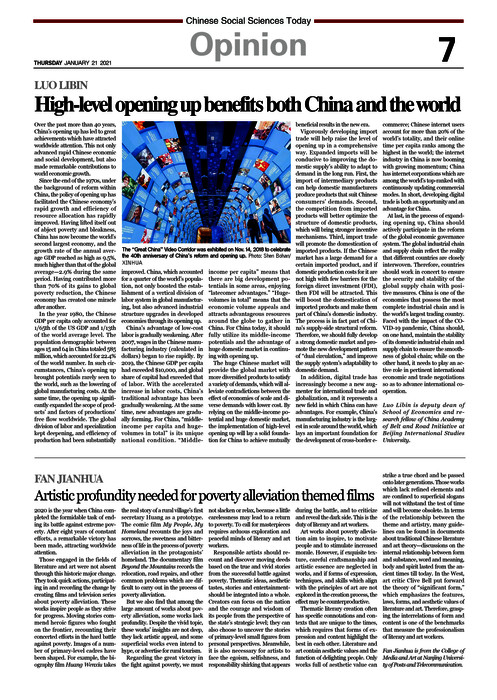High-level opening up benefits both China and the world
2021-01-19 15:52:18
The “Great China” Video Corridor was exhibited on Nov. 14, 2018 to celebrate the 40th anniversary of China’s reform and opening up. Photo: Shen Bohan/XINHUA
Over the past more than 40 years, China’s opening up has led to great achievements which have attracted worldwide attention. This not only advanced rapid Chinese economic and social development, but also made remarkable contributions to world economic growth.
Since the end of the 1970s, under the background of reform within China, the policy of opening up has facilitated the Chinese economy’s rapid growth and efficiency of resource allocation has rapidly improved. Having lifted itself out of abject poverty and bleakness, China has now become the world’s second largest economy, and the growth rate of the annual average GDP reached as high as 9.5%, much higher than that of the global average—2.9% during the same period. Having contributed more than 70% of its gains to global poverty reduction, the Chinese economy has created one miracle after another.
In the year 1980, the Chinese GDP per capita only accounted for 1/65th of the US GDP and 1/13th of the world average level. The population demographic between ages 15 and 64 in China totaled 585 million, which accounted for 22.4% of the world number. In such circumstances, China’s opening up brought potentials rarely seen to the world, such as the lowering of global manufacturing costs. At the same time, the opening up significantly expanded the scope of products’ and factors of productions’ free flow worldwide. The global division of labor and specialization kept deepening, and efficiency of production had been substantially improved. China, which accounted for a quarter of the world’s population, not only boosted the establishment of a vertical division of labor system in global manufacturing, but also advanced industrial structure upgrades in developed economies through its opening up.
China’s advantage of low-cost labor is gradually weakening. After 2007, wages in the Chinese manufacturing industry (calculated in dollars) began to rise rapidly. By 2019, the Chinese GDP per capita had exceeded $10,000, and global share of capital had exceeded that of labor. With the accelerated increase in labor costs, China’s traditional advantage has been gradually weakening. At the same time, new advantages are gradually forming. For China, “middle-income per capita and huge-volumes in total” is its unique national condition. “Middle-income per capita” means that there are big development potentials in some areas, enjoying “latecomer advantages.” “Huge-volumes in total” means that the economic volume appeals and attracts advantageous resources around the globe to gather in China. For China today, it should fully utilize its middle-income potentials and the advantage of huge domestic market in continuing with opening up.
The huge Chinese market will provide the global market with more diversified products to satisfy a variety of demands, which will alleviate contradictions between the effect of economies of scale and diverse demands with lower cost. By relying on the middle-income potential and huge domestic market, the implementation of high-level opening up will lay a solid foundation for China to achieve mutually beneficial results in the new era.
Vigorously developing import trade will help raise the level of opening up in a comprehensive way. Expanded imports will be conducive to improving the domestic supply’s ability to adapt to demand in the long run. First, the import of intermediary products can help domestic manufacturers produce products that suit Chinese consumers’ demands. Second, the competition from imported products will better optimize the structure of domestic products, which will bring stronger incentive mechanisms. Third, import trade will promote the domestication of imported products. If the Chinese market has a large demand for a certain imported product, and if domestic production costs for it are not high with few barriers for the foreign direct investment (FDI), then FDI will be attracted. This will boost the domestication of imported products and make them part of China’s domestic industry. The process is in fact part of China’s supply-side structural reform. Therefore, we should fully develop a strong domestic market and promote the new development pattern of “dual circulation,” and improve the supply system’s adaptability to domestic demand.
In addition, digital trade has increasingly become a new augmenter for international trade and globalization, and it represents a new field in which China can have advantages. For example, China’s manufacturing industry is the largest in scale around the world, which lays an important foundation for the development of cross-border e-commerce; Chinese internet users account for more than 20% of the world’s totality, and their online time per capita ranks among the highest in the world; the internet industry in China is now booming with growing momentum; China has internet corporations which are among the world’s top-ranked with continuously updating commercial modes. In short, developing digital trade is both an opportunity and an advantage for China.
At last, in the process of expanding opening up, China should actively participate in the reform of the global economic governance system. The global industrial chain and supply chain reflect the reality that different countries are closely interwoven. Therefore, countries should work in concert to ensure the security and stability of the global supply chain with positive measures. China is one of the economies that possess the most complete industrial chain and is the world’s largest trading country. Faced with the impact of the COVID-19 pandemic, China should, on one hand, maintain the stability of its domestic industrial chain and supply chain to ensure the smoothness of global chain; while on the other hand, it needs to play an active role in pertinent international economic and trade negotiations so as to advance international cooperation.
Luo Libin is deputy dean of School of Economics and research fellow of China Academy of Belt and Road Initiative at Beijing International Studies University.


